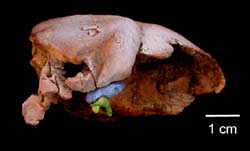| |

Middle ear of the fossil whale Remingtonocetus from India, approximately 43-46 million years old. The tympanic bone is seen from above, as it is cradling two of the ear ossicles, the malleus and incus (blue and green respectively, in false colors).
Credit: Artwork by Lauren Stevens
Select image for larger version
(Size: 19KB), or download a high-resolution TIF version of image (698KB) |
| |
| |
 Note About Images Note About Images |
ARLINGTON, Va.—An international team of scientists has traced the evolution of hearing in modern cetaceans (whales, dolphins and porpoises). "This study of the early evolution of whales demonstrates the changes that took place in whales' outer and middle ears, required for the transition from a land-based to a marine-based existence," said Rich Lane, director of the National Science Foundation (NSF)'s geology and paleontology program, which funded the research.
The findings are published in the Aug. 12 issue of the journal Nature.
The ear is the most important sense organ for modern toothed whales, say scientists, because these whales locate their prey using echolocation. Directional hearing is critical: A blind such whale could find food without much trouble; a deaf one would starve.
The study documents how hearing in these whales evolved. The research is based on cetacean fossils representing four groups of early whales. The earliest cetaceans, pakicetids (those that swam in ancient seas 50 million years ago), used the same sound transmission system as did land mammals, and so had poor underwater hearing. More recent cetaceans, remingtonocetids and protocetids (those that lived 43-46 million years ago), retained the land-mammal system, but also developed a new sound transmission system.
"The fossils document the ways in which cetacean hearing has changed, starting with ear fossils of whales' land ancestors and ending with the ear of near-modern looking whales," said Hans Thewissen, an anatomist at the Northeastern Ohio Universities College of Medicine (NEOUCOM). Thewissen and NEOUCOM researcher Sirpa Nummela led the study.
The newer system was similar to that of modern whales. The later whales could hear better in water than pakicetids could, and could also hear in air, but hearing in both media was compromised by the existence of two systems. With the advent of basilosauroids (approximately 40 million years ago), the old land-mammal ear disappeared, and the modern cetacean sound transmission system began its development. Although basilosaurids were not echolocators (they lacked the sound-emission equipment of later echolocators), they had taken a major step forward in refining underwater sound reception.
In addition to Thewissen and Nummela, the research team includes Sunil Bajpai, Indian Institute of Technology, Roorkee; S. Taseer Hussain, Howard University College of Medicine; and Kishor Kumar, Wadia Institute of Himalayan Geology, Dehradun, India. Support for the project was also provided by the Department of Science and Technology, India.
|
|
The National Science Foundation (NSF) is an independent federal agency that supports fundamental research and education across all fields of science and engineering, with an annual budget of nearly $5.58 billion. NSF funds reach all 50 states through grants to nearly 2,000 universities and institutions. Each year, NSF receives about 40,000 competitive requests for funding, and makes about 11,000 new funding awards. The NSF also awards over $200 million in professional and service contracts yearly.
Receive official NSF news electronically through the e-mail delivery and notification system, Custom News Service. To subscribe, enter the NSF Home Page at: http://www.nsf.gov/home/cns/#new and fill in the information under "new users."
Useful NSF Web Sites:
NSF Home Page: http://www.nsf.gov
News Highlights: http://www.nsf.gov/od/lpa
Newsroom: http://www.nsf.gov/od/lpa/news/media/start.htm
Science Statistics: http://www.nsf.gov/sbe/srs/stats.htm
Awards Searches: http://www.fastlane.nsf.gov/a6/A6Start.htm
|

